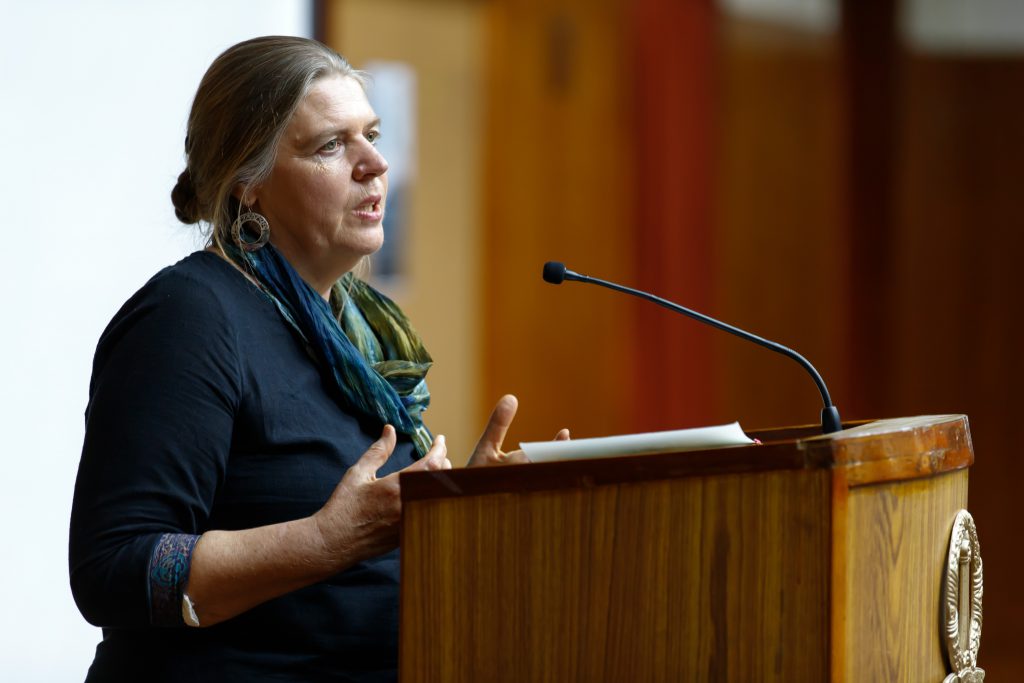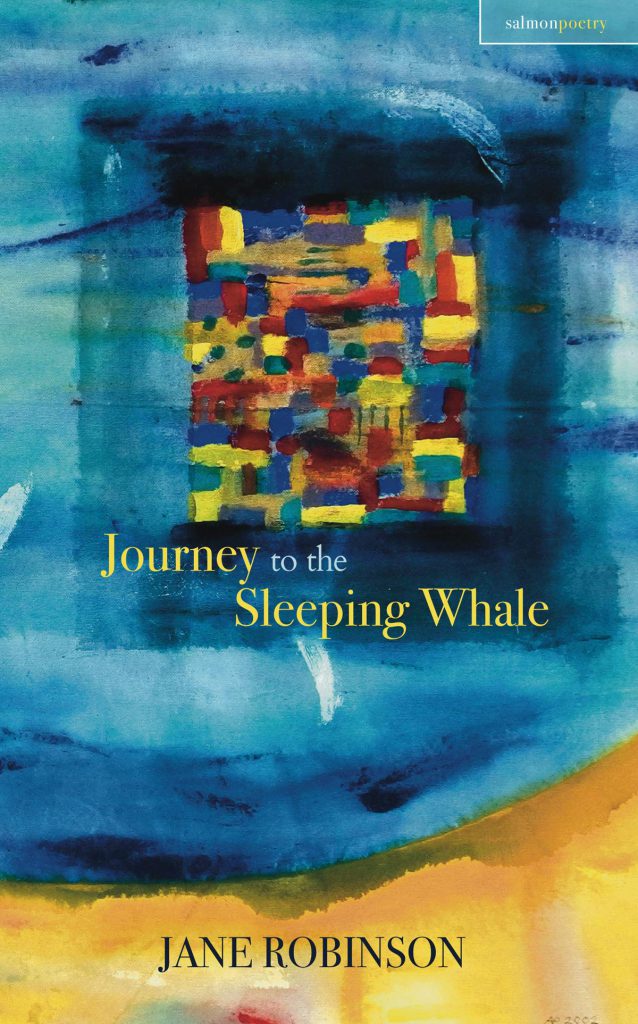
Jane Robinson was poet-in-residence this summer at the National Centre for Biological Sciences, Bangalore. Starting off as a biologist, she gradually turned to poetry and published her first book, Journey to the Sleeping Whale, in 2018. She was at IISc in June for a talk, “Of Poetry & Science”. In this email interview, she talks about growing up in Ireland, the diverse influences on her poetry, and how she uses it to engage with environmental issues.
Were you always interested in poetry while you were doing science? When and how did you make the transition to a full-time poet?
I always enjoyed stories and literature and, at the end of school, seriously considered pursuing art as a career. However, I decided to study science as it was interesting, logical and offered a path to a deeper and wider understanding of life. My reasoning was that while I could continue to read fiction, draw, sculpt or paint, it was unlikely that I would persist in scientific studies on my own. In many ways, this position was correct as I read widely outside science and dabbled in theatre. My engagement in science continued through graduate studies at Caltech: I got my PhD in biology for outlining a genetic pathway leading to an intracellular compartment within a cell, where molecules are degraded. As a cell biologist, I still marvel at the diversity of unicellular creatures, fungi and diatoms for instance, which are stunning in both their structures and their biology.
It is interesting to me now that while I was busy with biology research, I was subconsciously mulling over the idea of writing poetry though, at that time, I did not have any overt interest in poetry, being more attracted to fiction and creative non-fiction. Italo Calvino was one of my favourite authors, perhaps because he not only bridged the gap between science and literature but also between fiction and other forms of literature such as poetry and essays.
My transition to poetry was not immediate. I began by writing essays about environmental decay but, lured in by Seamus Heaney’s suggestion that ‘poetry is the mathematics of language’, I gradually learnt and practiced the craft of poetry.
Does your training in science have any influence on your poetry?
Yes. I approach each poem as a fresh exploration or investigation. Although the initial inspiration is frequently a matter of chance or emotion, I read around many topics in a logical way and this feeds into my writing. A poem is a human-made thing, as is a good experiment. But the craft of poetry reaches beyond logic and rhetoric to follow a path to often surprising resolutions. This is accomplished by following patterns of language, rhythm or sound to a place where the subconscious has a chance to speak.

(Image courtesy: Salmon Poetry)
Your work, with its stark imagery of an environment in distress yet one that is populated with life, from frogs and thylacines to whales, may be called “ecopoetry”. Could you tell us more about this genre of poetry, perhaps tracing its origins and dominant themes?
Ecopoetry is a neologism for a poetry that celebrates humans’ home place in nature, and in these times it has no choice but to note the destruction of that home or oikos (ecos). With origins in older and indigenous place-aware poetry, nature poetry gradually evolved into environmental poetry and came to be called ecopoetry. A broad range of both form and content along this continuum could be said to contribute usefully to the genre. Thus, ecopoetry attempts to convey all dimensions of: ‘reciprocity between human and non-human nature’ (J. Scott Bryson), ‘encounter between a human and his context’ (A. Oswald), and to lament our ‘lack of place awareness’ (W.S. Merwin). While J. Shoptaw goes further: ‘An ecopoem is environmentalist not only thematically, in that it represents environmental damage or risk, but rhetorically: it is urgent, it aims to unsettle.’ Some ecopoets attempt to conjure a more balanced future in which humans respect all species and appreciate the necessary complexity of ecosystems.
In the words of Jonathan Bate (The Song of the Earth, 2000), a central idea of ecopoetics is: ‘we must hold fast to the possibility that certain textmarks called poems can bring back to our memory humankind’s ancient knowledge that without landmarks we are lost.’ Interpreted with the perspective of humanity’s evolutionary history, Bate’s observation implies that without deep connections to plants, animals and a living wilderness, we are lost. Interestingly, these connections are richly represented in writings in diverse languages, ancient texts and local dialects. It is important to preserve these too, as, without images and memories of what we are about to lose, we are lost.
A more general question is what environmental poetry contributes over similarly motivated prose. Bill McKibben who wrote The End of Nature, 1989, one of the first popular books about the climate crisis, about 25 years later commented on the limits of prose and suggested that poetry might be more successful. In a sense, poetry may be able to directly access deeper, and more ancient, emotional brain regions: bypassing defensive logical or analytical filters that must be navigated by prose.
Poems, if read and disseminated, can reach people directly and reconnect us to the stable source of our humanity. A poem does not pronounce but it explores, questions and suggests. It finds its own quiet way. It exists. There have been enough large-scale inventions, pronouncements and arguments – poetry hopes to sleep in your ear and catch hold of your imagination.
Were the environmental themes and the appearance of marine life in many of your poems triggered by any particular experiences, perhaps through your work as a biologist?
Naturally, my involvement with environmental and marine themes is influenced by experience. Freshly arrived in Pasadena, a suburb of Los Angeles, I was surprised how perfectly normal it was considered to be surrounded by asphalt, smog, freeways and concrete culverts, instead of by the quiet roads, trees, meandering streams and fields familiar to me in Ireland. The smog, of course, was acknowledged as a problem but not the infrastructure that caused it. Until I learned how to drive, I was restricted to Pasadena: rights to develop a potential Los Angeles-wide public transport system had reportedly been purchased and killed by Ford, who made and sold cars instead. The many quiet streets of Pasadena and perfectly groomed gardens and parks were an artificial paradise, a Hollywood set – really a damaged ecosystem, in which the native oak chaparral had been replaced first by the settlers’ orange groves and then by upmarket real estate.
My fellow students at Caltech had flown in from different states or from different continents. Although my contemporaries were extraordinarily gifted scientists focused on biological problems, few of us knew names of the local wildflowers, birds, insects or trees, let alone their origins or ecology. The deeper I got into my genetic and cell biological research, the more aware I grew of this intellectual void, which I felt restricted the full development of a self-reflective and responsible society. I read some of the great North American essayists, many of whom had environmental concerns: Rachel Carson, Annie Dillard, Edward Abbey, Wes Jackson, Wendell Berry – and these led me in a different direction.
A fondness for marine themes likely comes from two sources. First, from the proximity of Dublin to the sea: growing up five kilometers from the coast, I swam in the sea during all seasons of the year and feel most at home with the smell of seaweed and misty sea breeze. Second, with my father, we sailed during summer holidays around the coast of Ireland in a twenty-foot boat and read seagoing adventure stories – anything from fiction, such as Erskin Childers’ The Riddle of the Sands and Arthur Ransom’s We Didn’t Mean to go to Sea, to real-life reconstructions of historic voyages including Thor Heyerdal’s Kon Tiki Expeditionand Tim Severin’s Brendan Voyage.
Some of the poems in your collection, Journey to the Sleeping Whale, are about women scientists – Marie Curie, Rosalind Franklin, Martha Maxwell – and you mention Amelia Earhart in a poem too. What drew you to them?
I feel quite protective of a certain type of creative person who does magnificent work but somehow doesn’t seem to get enough credit for it. More often these are women. Both Rosalind Franklin and Martha Maxwell fall into this category and both, oddly enough, died of ovarian cancer at a very young age. My poems allude to this but also to the frustration of having ‘vultures come down’ into their creative work and carry it away. Some other interesting women I have written about who didn’t make it into this first book include Rachel Carson, author of Silent Spring, and the forgotten Irish poet, Madge Herron. As for Amelia Erhardt, for a while, I found her wildly beautiful and inspiring but there was also an element of doubt – a question about us adventurously sleepwalking into an extravagant, tragic and misguided future.

Pangur Bán, built by Robinson’s father (Photo courtesy: Jane Robinson)
Growing up in Ireland, or perhaps when you decided to switch to poetry, did you have a role model?
My parents were both excellent role models but I particularly admired my father who liked to make things. When I was two years old, he made a canoe from wood and canvas and we went on an expedition down the River Loire in France. That was the first of many unusual family trips, navigating canals and coastlines in very small boats and camping here and there. My mother was a great cook and taught us many skills and games. Through her actions, more than through instruction, we learned to live a full life, thrifty with supplies and minimal in waste. My mother encouraged me in art and reading, while my father was very interested in science. When I was twelve years old, my father decided to design and build a seaworthy boat to sail around the world. He made his initial designs at the kitchen table by sketching in pencil on the backs of cereal boxes and, over the next several years, built the boat by hand in the garden with help from friends and family. This took a long time but his boat, Pangur Bán, held up beautifully as he sailed around the world for several years and well over a 100,000 nautical miles. Sadly for me, this was after I had left home to study in America, so I was not part of these voyages. My father was concerned about climate change a long time before it became mainstream news and his travels were powered by wind alone, though there was a small engine to get the boat out of tricky situations when anchoring in harbour etc. My poetry collection, Journey to the Sleeping Whale, celebrates and commemorates this voyage in several poems and in the marine imagery threaded through the book.
Amit Roy is a PhD student at the Department of Physics, IISc




